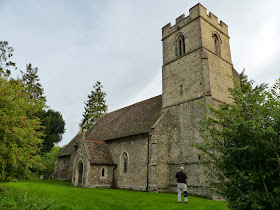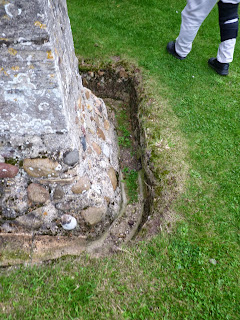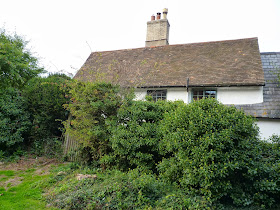Larry my brickmason was intrigued with the stonework, especially the way drainage was provided around the base of the church. Simple and effective.
Like so many buildings of that era, this church too was built of stone, both cut and what I would call cobbled. Some buildings used a material called clunch which, according to Wikipedia, is "a traditional building material used mainly in eastern England and Normandy. It encompasses a wide variety of items such as irregular lumps of rock either picked up from the fields, orquarried by being cut from the bedrock in regular-shaped building blocks. Clunch is predominantly chalk/clay-based and is bedded in mortar to form walls. It is a particularly soft building material. It can be cut by a saw when in its softer state; when it has been quarried out of the ground it still contains a large amount of water.[1] When the stone dries out it becomes harder, and is not as easy to cut.
I don't know if this church was built using clunch, but it does not appear to me that it was.
Stones old and new dotted the grounds. This one is for John Radford, one of my ancestors.
Here as in other cemeteries the stones are not necessarily as old as they appear; the soft stone used to make them did not stand the test of time well. I learned that when a churchyard became full, a stone would be removed and leaned against the church and another grave dug on top of the former one. Because of the lack of space many people are opting for cremation. I can understand that; it was the choice of my granny and my uncles. And yet. there is something comforting about visiting a grave, seeing the engraved name and knowing for certainty that this is their resting place.
I was surprised to find among these stones the names of families that currently live near me on Joe's Run: Winter and Parsons. I wonder if in long ago days our ancestors trod this same English churchyard?
My grandfather's grave:
and the beautiful stone my granny chose for this young husband who left her so suddenly, so long ago:
My granny, I found, was a strong woman. After Thomas' death, she would lose her big house at Highfields. Although the farm owner offered to let her stay, she would not hear it. Instead, she moved the tenants out of the house she and Thomas had built and moved her five children and all their belongings there in a handcart, according to my Aunt Grace. She would have no part of charity. Some years later when my Aunt May was working for a doctor at Caxton, one room of Ashlyn was used as a surgery (doctor's office), which brought in a little money that was probably quite welcome. My aunt, and my Uncle Ted too, remembered seeing a cabinet full of medicines in the room, which they never touched.
Julie and I were mystified as to who might have cleaned the grave and the stone. She had wanted to get to it but with her father's poor health and her mother's needs, along with her own family, she had not had time. We later learned that another cousin, Robert, had been out to care for it. I wonder if it was also Robert who put these flowers in the little window at the church's entrance?
We were not able to enter the church, sadly; it was well locked up so that pleasure will await my next visit. I was happy just to wander the grounds and admire the stonework of the building.
I heard Julie give a little yelp of pleasure; under a tree in an area of the graveyard not as well cared for, she had found the grave of Susanna Radford which she had been looking for. The stone was barely readable. I thought how odd it was that my mother should have chosen the name "Susanna" for me. She had expected me to be another boy after three boys in a row and planned to name me Stephen. She ended up picking my name from a name book. And here in this cemetery I find that what she chose was a name that appeared twice in our family history.
A murder of crows cried overhead while we walked the grounds, somehow in keeping with the feeling of going back in time here.
An intriguiing design on this headstone caught my eye. A sleeping angel, perhaps?
Just on the other side of the hedge was the parish hall. I believe Julie said this used to be the school and would have been where my mother attended classes.
And so our day ended; it had been a full one from start to finish; I had much to think about, much to try to remember, and I am so grateful to my cousin for taking the time to show me places that have placed my mother's memories and stories in context.
Copyright Susanna Holstein. All rights reserved. No Republication or Redistribution Allowed without attribution to Susanna Holstein.




















The church yard looks a lot tidier than I remember it, Sue. The church is built mainly of stones gathered from the fields of the area. The soil is of glacial origin and marks the southern limit of glaciation during the last Ice Age. The ice sheet spread down from the north of England but began to melt hereabouts and simply dumped all the material it had eroded along the way. This is known as boulder-clay which neatly sums up what you'll find if you go tramping the fields. These boulders come from many different sources and you can see the variety of colours in the walls of the church. The corners of the building are probably limestone from Barnack, near Peterborough, imported at some expense because you can't build strong corners with field stones. The little window might be a "squint" to allow the bellringers to see when wedding or funeral processions were entering the churchyard. all of which is probably more information than you wanted!
ReplyDeleteRe finding names of current neighbors in an English cemetery: There were frequently entire villages which migrated en masse to America, sometimes encouraged by owners of large estates who wanted to settle their property, and sometimes by local communities united in a particular religious congregation. Early settlers in New England and Virginia came from different parts of England, for example and (in my case) many of those who came to MA with Winthrop in 1630 had been previously acquainted in England.
ReplyDeleteWhat a beautiful place to rest, and I love the headstone your grandma chose.
ReplyDelete=)